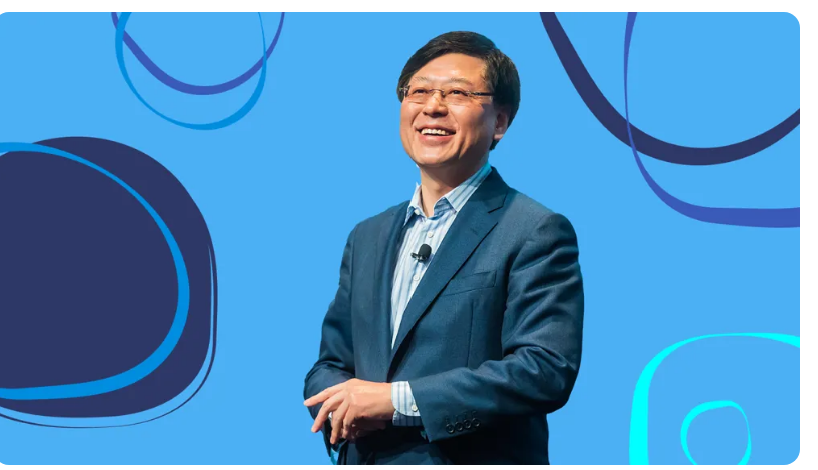[Mipcom2025]"AI is a Tool, the Artist's Message is the Purpose"
Korea Arts & Culture Education Service Unveils 50-Day AI Training Program Results at MIPCOM
- Empowering Artists, Humanizing AI: Korea’s Model for Future Creative Education
- From Tools to Transformation: How Korea’s 50-Day AI Arts Program Redefined Creation
- Where Art Leads and AI Follows: A New Chapter in Korea’s Creative Evolution
[CANNES - Special] "AI can produce astonishing results, but without human philosophy and emotion, it cannot become art." Korea Arts & Culture Education Service (KACES) unveiled the results of its 50-day intensive training program designed to expand creators' AI utilization capabilities and scope at MIPCOM 2025, the world's largest broadcast and video content market in Cannes, France.
The session, moderated by Jung Han, CEO of K EnterTech Hub, served as a showcase for AI-generated works and a platform to share lessons learned from the educational process. The systematic education model, built upon 20 years of arts education infrastructure and producing "professional-grade" rather than "student-level" results, drew significant attention from the international arts education community.
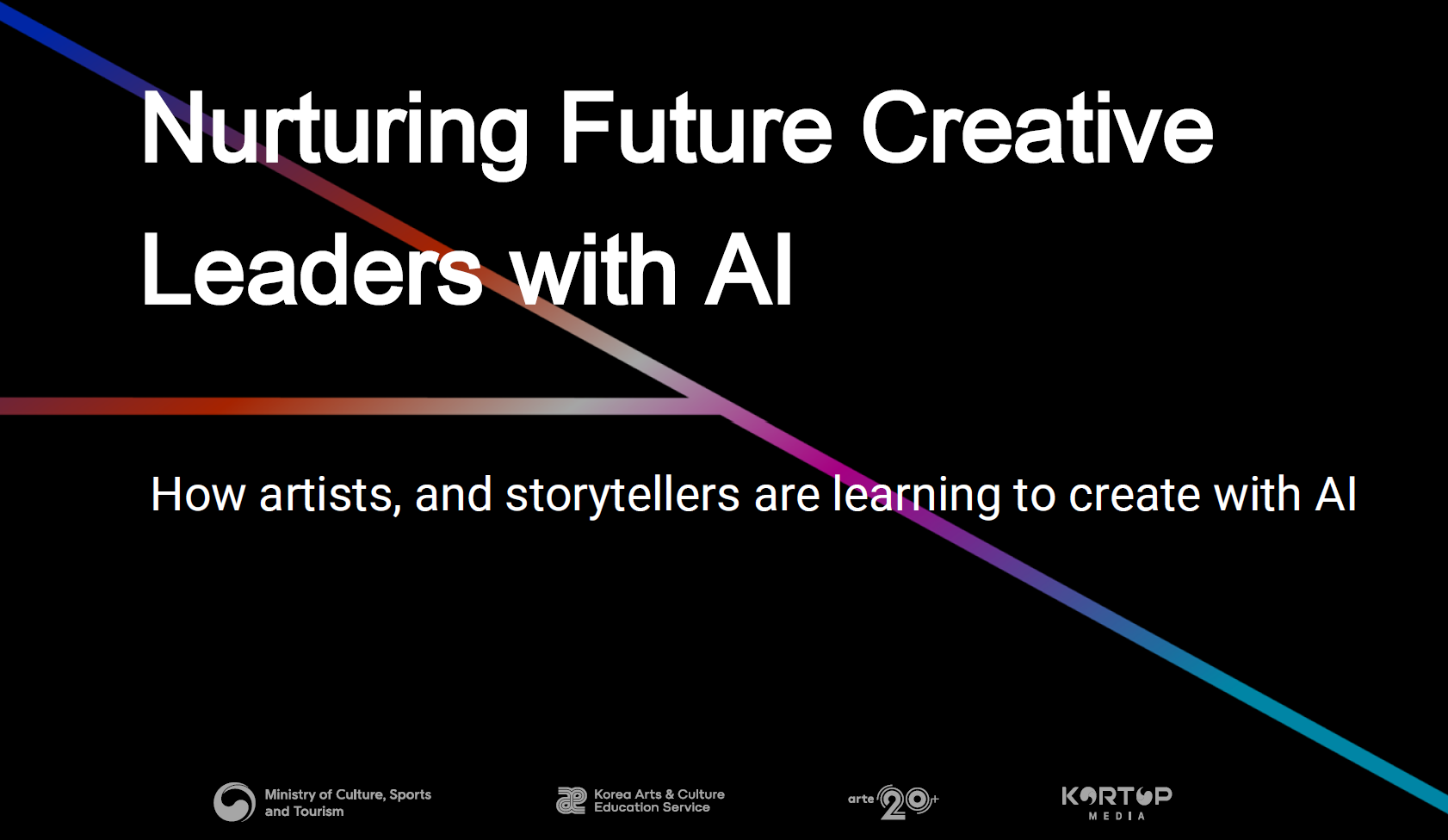
K EnterTech Hub Moderates 50-Day Training Results Showcase
The session titled "Nurturing Future Creative Leaders with AI," hosted by Korea Arts & Culture Education Service, was held at the Palais des Festivals in Cannes in mid-October with approximately 200 attendees. Moderated by Jung Han, CEO of K EnterTech Hub, the session was not merely a forum for discussion but a results presentation event showcasing the outcomes of a 50-day training program designed to expand creators' AI utilization capabilities and range, while sharing the educational insights gained through the process.
The session consisted of presentations, a roundtable discussion, and a Q&A session. Speakers included Professor Song Jeong, Head of the Kim Jaechul Graduate School of AI at KAIST and KAIST ICT Endowed Chair Professor; Ms. Kim Ja-hyun, Director of Korea Arts & Culture Education Service; and Mr. Kim Ho-sang, CEO of KT ENA. The roundtable featured Director Kang Chul-woo (AI Artist, Arte Academy Instructor), Professor Kim Ji-hyun (Arte Academy Instructor), CEO Jo Yeol-hee (Creator and Entrepreneur, Arte Academy Student), and Film Editor Han Eon-je (Creator, Arte Academy Student), who shared their firsthand experiences and outcomes from the 50-day program.
In his opening remarks, Jung Han stated, "Today, Korean innovators and global partners have gathered to discuss how AI is transforming creative education, content production, and the arts industry, and to showcase the actual educational outcomes."
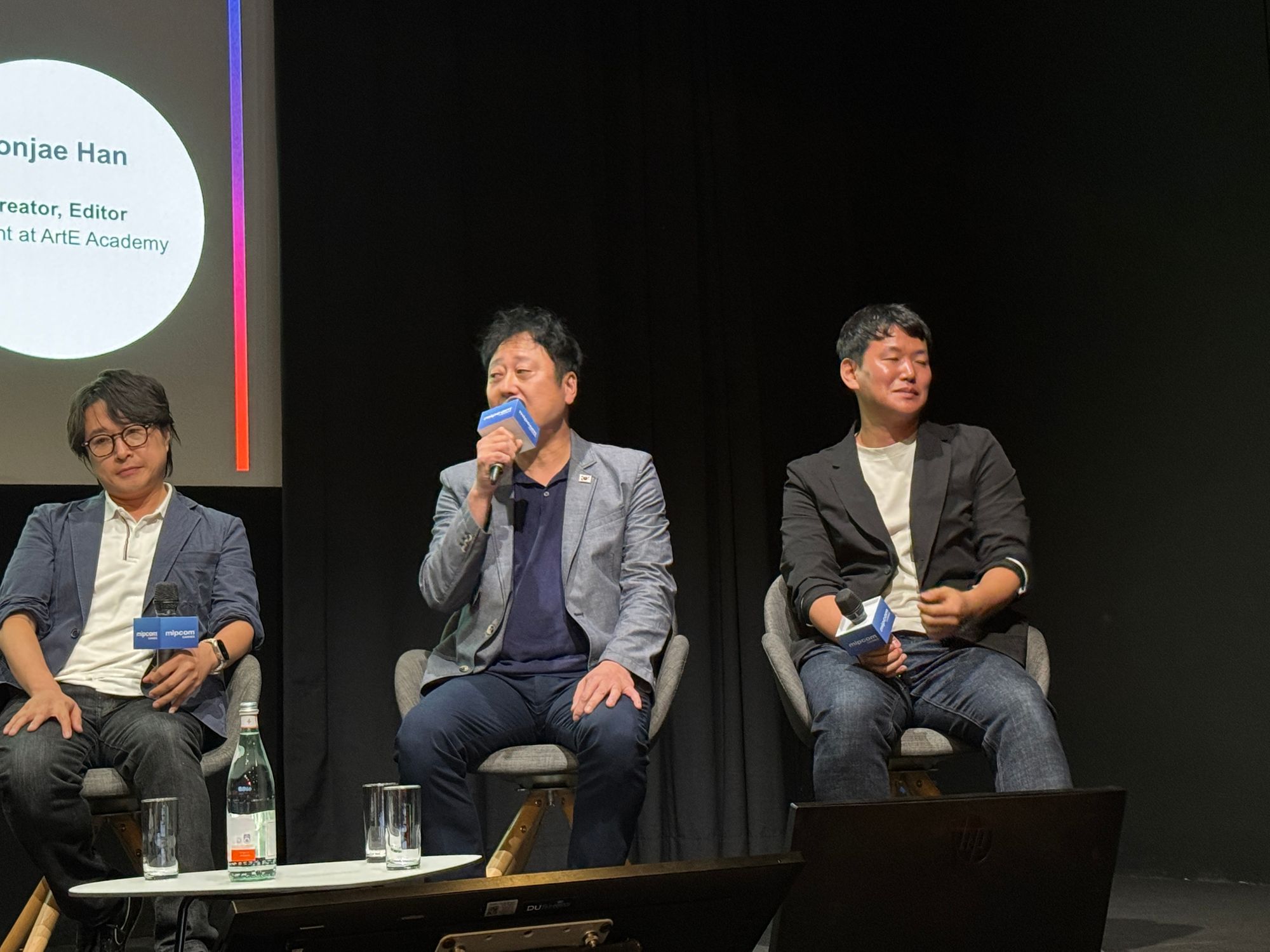
Professor Song: "Korea at the Intersection of AI Technology and Culture"
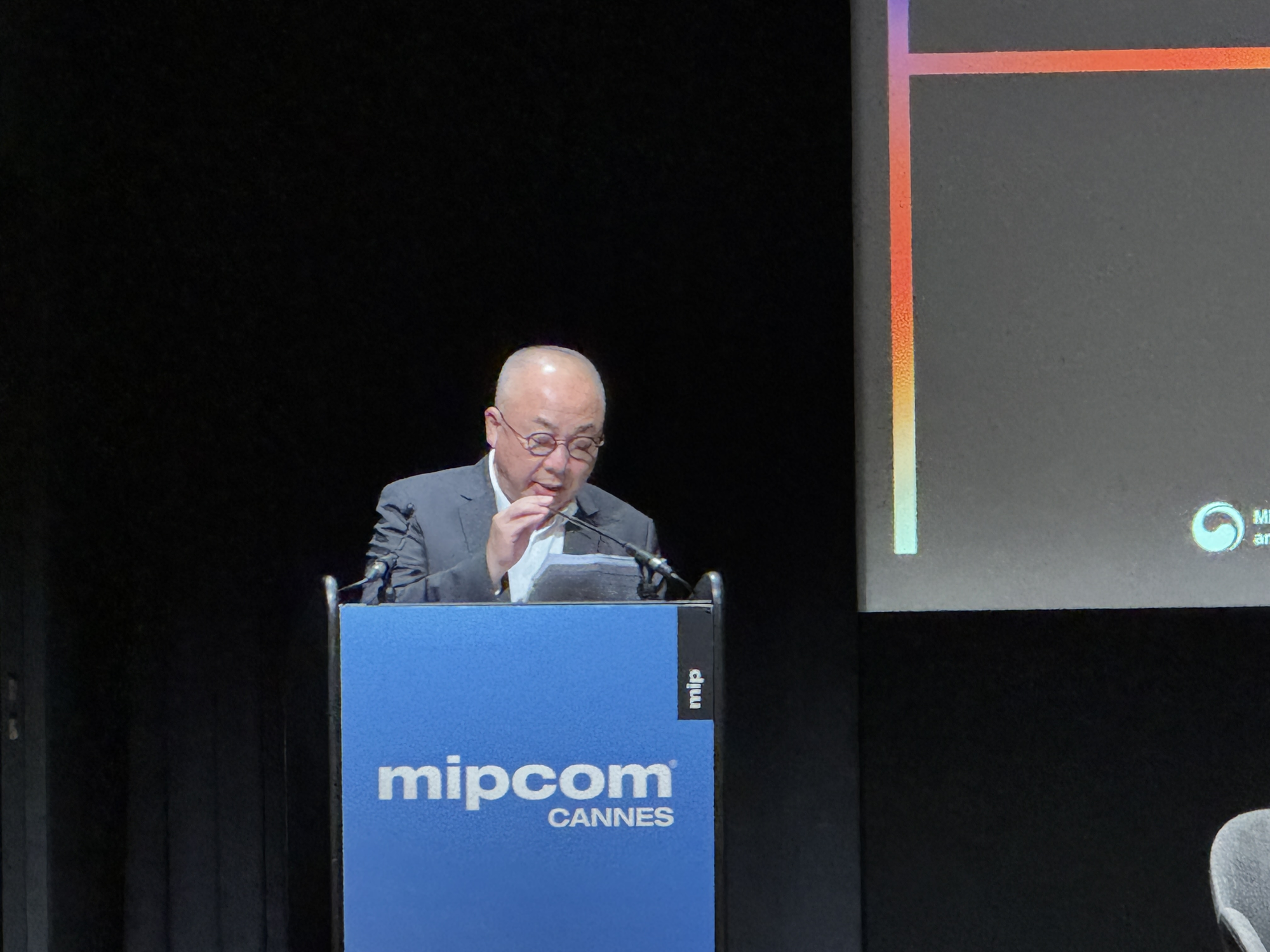
The first speaker, Professor Song Jeong, Head of KAIST's Kim Jaechul Graduate School of AI, presented on "Trends and Prospects of AI Arts and Culture Content Development in Korea." Professor Song explained that Korea occupies a unique position as both an AI technology leader and a global cultural market influencer through K-content, emphasizing that Korea possesses optimal conditions to combine strengths from both domains.
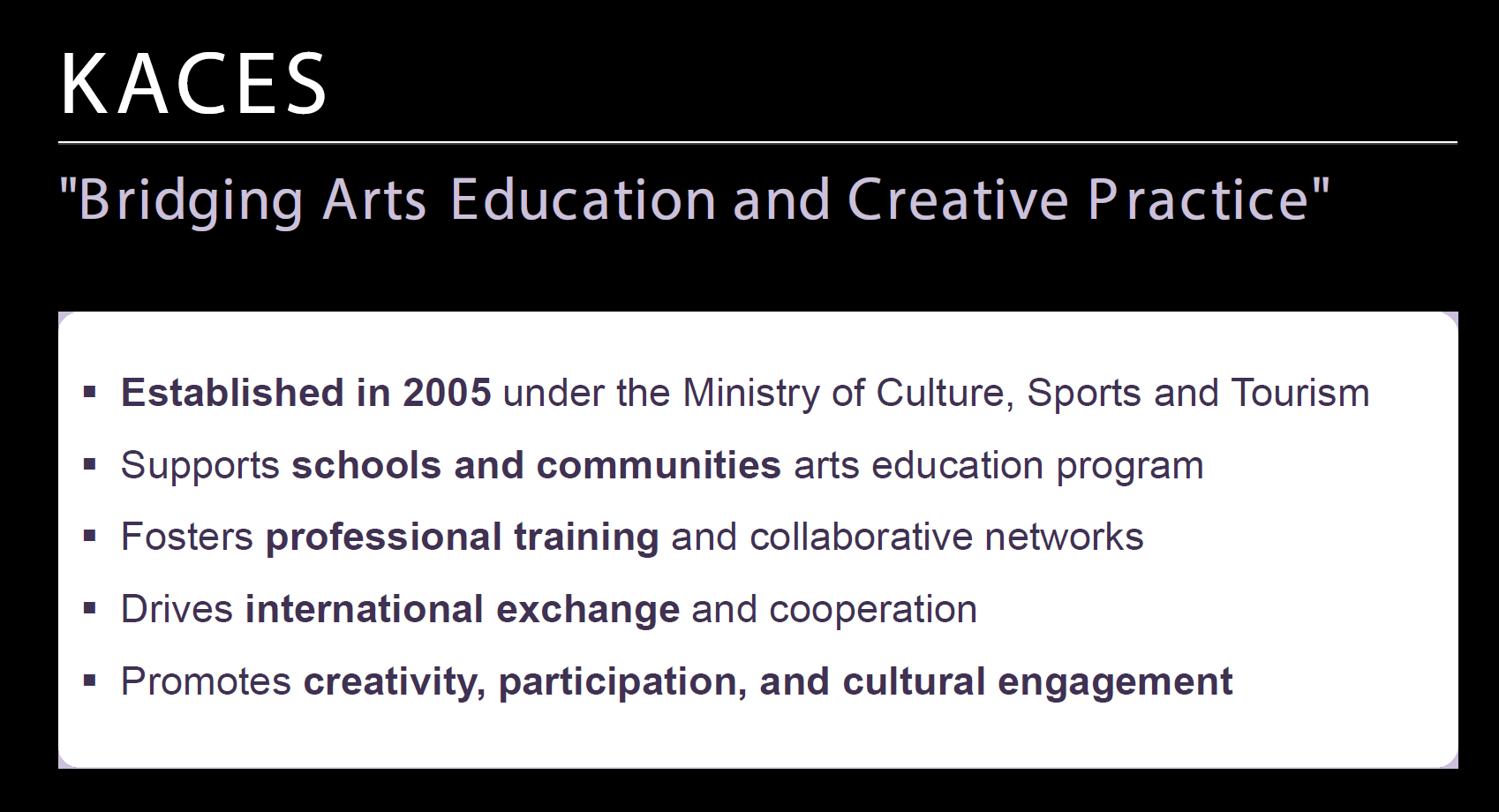
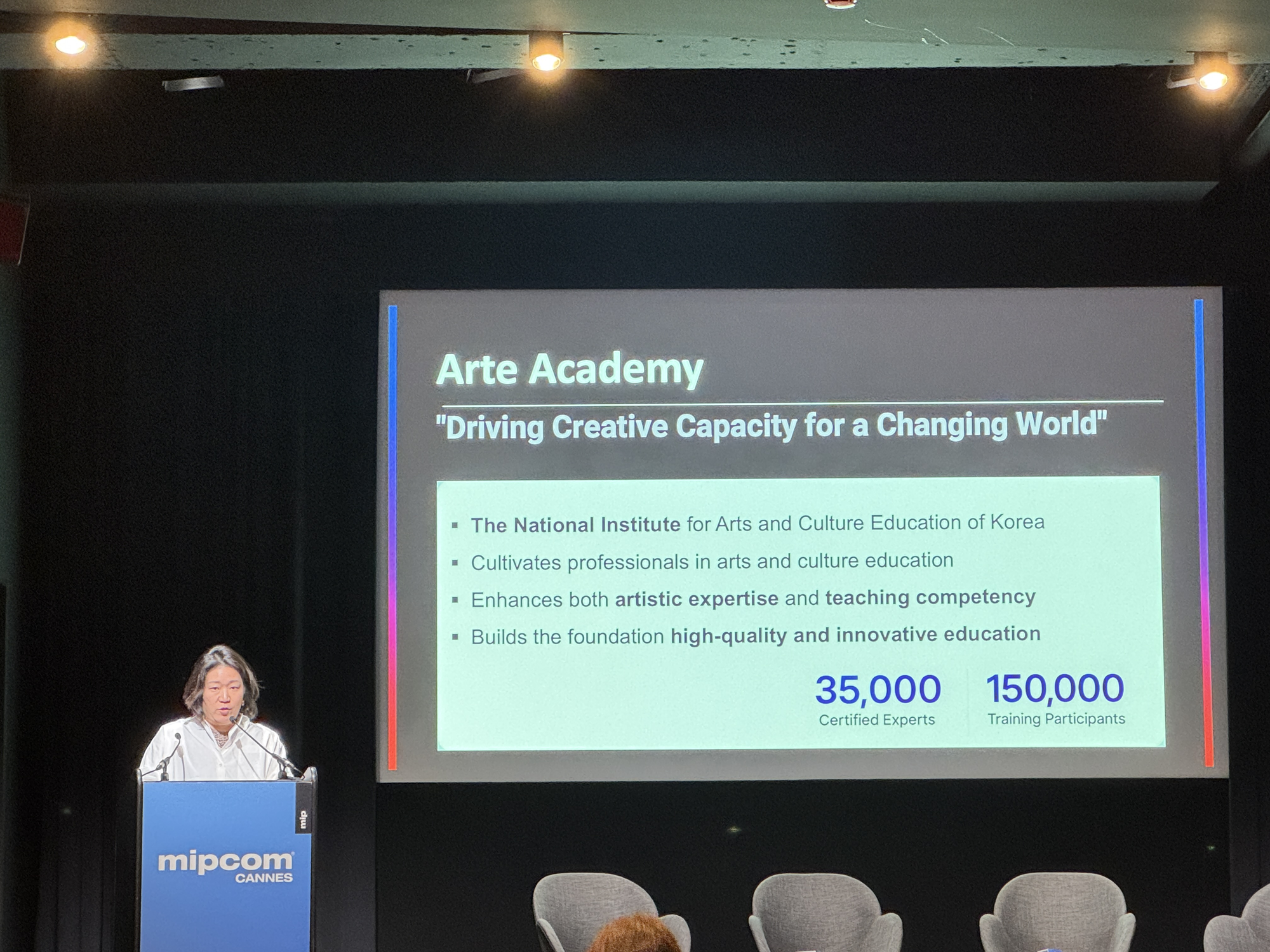
Director Kim: "Artists Lead, AI is a Partner"
The presentation by Ms. Kim Ja-hyun, Director of Korea Arts & Culture Education Service, outlined the philosophy and methodology of the 50-day training program. Under the theme "AI and Arts Education: Building the Next Generation of Creative Leaders," Kim emphasized that "in an era where digital-native generations are already creating freely with AI, safeguarding artistic authenticity is more essential than ever. Arts education must keep creativity deeply human."
She posed a fundamental question: "Who leads creation—Technology or the Human spirit?" and presented a clear philosophy: "Creativity loses its true essence without human artistry. Artists shape creation, with AI as a partner in innovation. Future-ready educators must unite artistry with AI, ensuring creativity guides, not technology."
50-Day Program Built on 20 Years of Infrastructure
Director Kim detailed KACES's history and the specific content of the 50-day training program. Established in 2005 under the Ministry of Culture, Sports and Tourism, KACES has supported arts education programs in schools and communities, fostered professional training and collaborative networks, and driven international exchange based on the Arts and Culture Education Support Act.
Notably, Arte Academy, the National Institute for Arts and Culture Education under KACES, has cultivated 35,000 certified experts and 150,000 training participants under its vision of "Driving Creative Capacity for a Changing World." The 50-day intensive training program to expand creators' AI utilization capabilities and range was built upon this 20-year infrastructure.
Director Kim presented three core principles of the 50-day program: ▲Beyond Tools - exploring creative potential and ethical use ▲Creative Voice & Expertise - strengthening artistic identity and storytelling ▲Collaborative Learning - co-creating new models of arts education between artists and technologists.
Four Dimensions of Impact
Director Kim outlined the impact of AI arts education across four dimensions: On a Personal level, artists strengthen their own creative practice by integrating AI into their artistic identity. On an Educational level, arts educators adapt methods to include AI literacy without compromising artistic authenticity. On a Policy level, KACES builds a national framework to cultivate AI-ready professionals in arts education. On a Global level, Korea contributes to global dialogue on AI in arts education, shaping future standards and cultural sustainability.
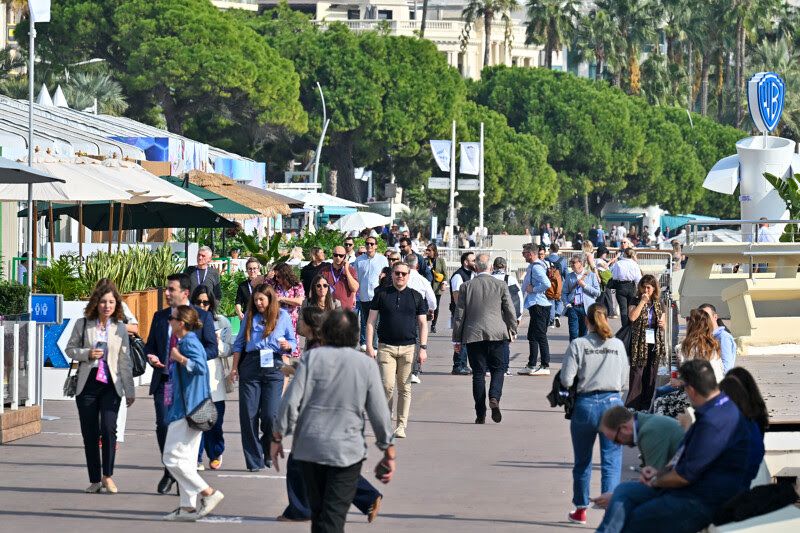
CEO Kim: "Real-World AI Applications in Industry"
Mr. Kim Ho-sang, CEO of KT ENA, presented on "AI-Driven Content Production," sharing cases from actual industry settings. Kim detailed the use of AI to recreate historical scenes in the drama "My Golden Star," significantly reducing production costs and time; the maximization of efficiency by creating channel promotional videos with AI; and the development of AI dubbing technology emphasizing Korean cultural elements and AI-driven projects to expand global market opportunities.
50-Day Program in Practice: From Learning to Creation
The roundtable discussion provided specific details about the 50-day training program's content and outcomes. When asked about the program's purpose, an instructor explained, "The program went beyond teaching technical skills. Its true purpose was to empower artists to expand their creative universe with AI. Many artists have vision and imagination but face barriers like cost, time, and resources. AI helped remove those barriers, giving them back the freedom to create and express without limits."
The 50-day program was structured in stages: In the beginning, participants learned fundamentals and tools. In the middle, they transformed ideas into actual works. In the final stage, they moved into real-world applications like professional video production, exhibitions, and brand collaborations. The instructor assessed: "What started as 'learning' gradually turned into real 'creation and achievement.'"
Participant backgrounds were highly diverse, including actors, writers, directors, designers, entrepreneurs, as well as professionals from branding and digital design. The tools used covered four areas: image generation for concept visualization, video generation and editing for cinematic storytelling, music AI for original scores, and voice synthesis for narration and performance.
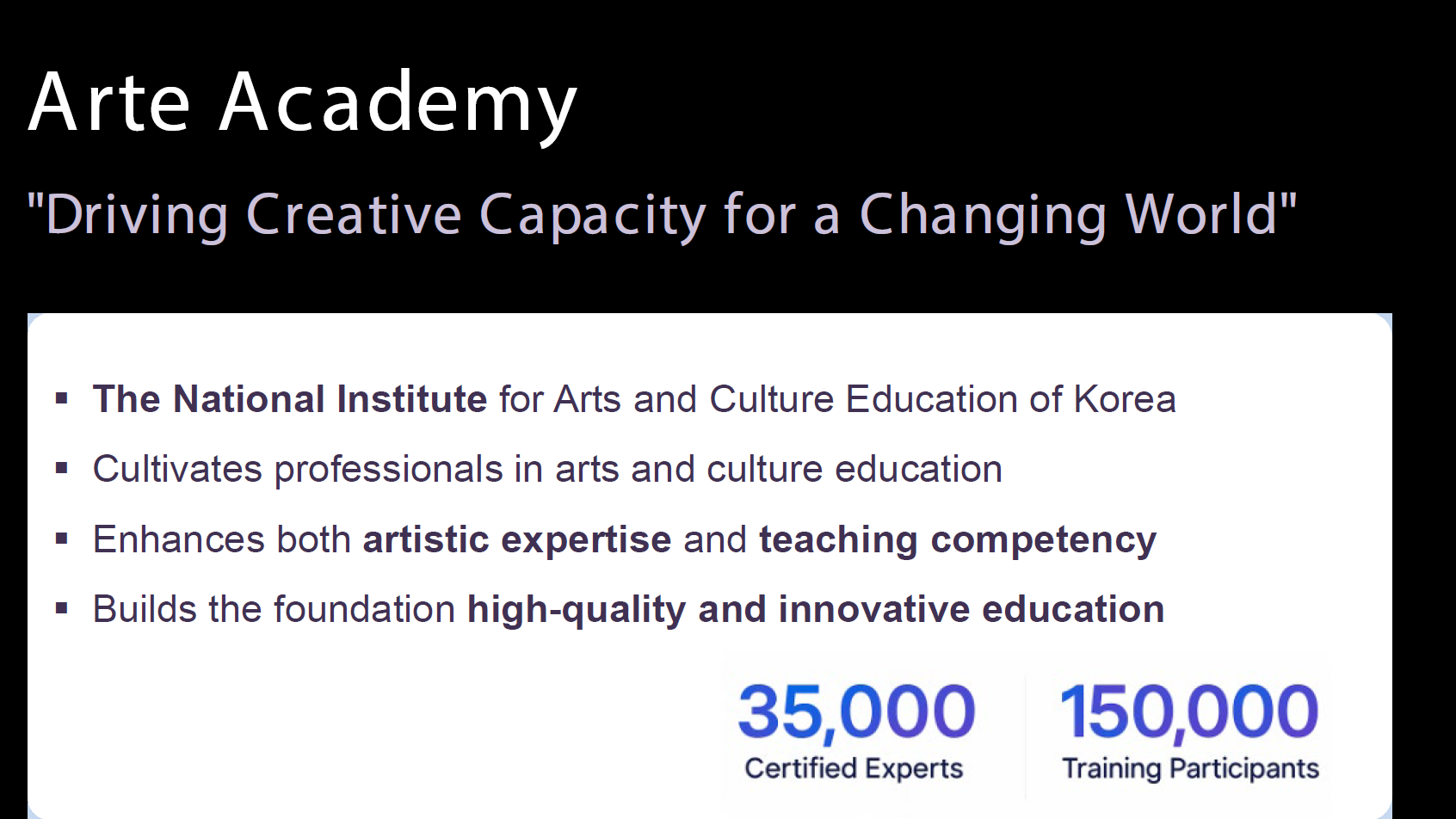
Professional-Grade AI-Generated Works
Regarding the program's outcomes, an instructor stated, "Dozens of high-quality artworks—videos, images, even sound pieces—were completed. Some went into exhibitions, and some were used in real campaigns. What stood out was that the works weren't 'student-level'—they were professional, with commercial potential. That was a big achievement in such a short time."
The instructor provided a specific example: "One composer used Suno to create a soundtrack that sounded like a professional film score in just three days."
Voices from Participants
Student Jo Yeol-hee shared, "At first, 50 days sounded like a long commitment, but the way it was structured actually made it easier to stay engaged. In the beginning, learning the basics gave me confidence—I wasn't overwhelmed. By the middle, when we started turning ideas into actual projects, I felt a sense of achievement. And in the final stage, I realized, 'This isn't just practice, it's something I can actually use in my career.'"
The transformation process of participants drew particular attention. Student Han Eon-je confessed, "At first, many of us were nervous—some even worried AI might replace our art." However, "As we tried it, we realized it actually expanded our creative voice. I visualized scenes I had only imagined, and another classmate finally filmed a sequence he had abandoned for budget reasons. Our skepticism turned into excitement."
One participant testified, "I completed a project I had dreamed of for years in just a few days," while another stated, "Learning AI helped me understand myself better," demonstrating that AI education can become a process of self-discovery beyond technical skill acquisition.
Using AI, "Extension, Not Replacement"
When asked about personal lessons learned as an instructor, Director Kang Chul-woo stated, "AI can produce astonishing results, but without human philosophy and emotion, it cannot become art. Through this process, it has become even clearer that AI is not a substitute but a companion. AI may extend the essence of the artist, but it can never truly replace them."
The most emphasized message throughout the educational process was that "AI is just a tool; the artist's voice is the core." The instructor explained, "Technology doesn't replace identity—it amplifies it. In fact, one participant said, 'Learning AI helped me understand myself better.' That's the power we wanted them to discover."
"Balance is Most Important"
When asked what artists should be mindful of when using AI, student Han Eon-je responded, "The most important thing is balance. Even if AI can do amazing things, if you don't put your own voice and philosophy into it, it's just another image or sound. We kept hearing: 'AI is the means, but your message is the goal.' That's something I'll carry forward."
Challenges and Overcoming
The biggest challenge was the gap in participants' technical skill levels. The instructor explained, "We managed the project through 1:1 feedback. In the end, despite starting from different levels, everyone was able to complete the course successfully."
From a student perspective, Han Eon-je shared, "For me, the hardest part was the steep learning curve at the beginning. I had never worked with AI tools before, and at first I was worried I wouldn't be able to keep up." However, "The instructors gave a lot of one-on-one support, and working in groups also helped because we could share knowledge. Over time, I realized that I didn't need to be 'perfect' with the technology—what mattered was how I used it to express my ideas. Once I understood that, the challenge turned into motivation."
"A Turning Point for Korean Arts"
Regarding the impact this experience could have on the Korean arts scene, the instructor stated, "This program marks a turning point. Now, artists can create world-class works without budget or scale limits, and even individuals can bring their films or multimedia projects to the global stage."
Additionally, "AI makes it easier for everyone to express themselves through art, allowing more imagination and participation. For art educators, AI offers helpful tools that make art more open and welcoming for all."
"This is Only the Beginning"
At the session's conclusion, the instructor stated, "This 50-day journey was only the beginning. The works presented today prove what is possible when artists and AI work together."
Student Jo Yeol-hee responded, "Yes—and for us, it's the start of a much bigger journey. With AI, we now feel ready to step onto global stages with confidence."
The instructor concluded, "We thank you for your interest and support, and we look forward to continuing this journey with all of you."
Jung Han closed the session by saying, "May this session inspire meaningful dialogue and fresh collaboration as we work together to nurture future creative leaders with AI. If you have any questions or wish to continue the discussion, please feel free to visit our booth."
[ Note] Systematic Education Proven by Results
What impressed me most about covering the MIPCOM session was the concrete outcomes produced by Korea Arts & Culture Education Service's 50-day training program. This was not a seminar merely presenting theories and philosophies, but a results presentation showcasing actual AI-generated works to the world and sharing lessons learned from the educational process.
A 50-day intensive training program built upon 20 years of infrastructure that produced 35,000 certified experts and 150,000 training participants. The result: works with commercial potential at a "professional level" rather than "student level." Some went into exhibitions, some were used in actual campaigns. This was the power of systematic education, proven by numbers and tangible outputs.
The question posed by Director Kim Ja-hyun—"Who leads creation—Technology or the Human spirit?"—is a fundamental dilemma facing all creators in the age of generative AI. The answer provided by the 50-day training program was clear: "Artists shape creation, with AI as a partner in innovation."
Director Kang Chul-woo's statement that "AI can produce astonishing results, but without human philosophy and emotion, it cannot become art" was both a critical reflection on technological determinism and a reaffirmation of art's essence. This gains credibility from the fact that it wasn't merely a declaration but was actually implemented through concrete works via a systematic 50-day program.
Particularly noteworthy is the program's staged structure: systematic design progressing from learning → creation → practical application, overcoming technical gaps through 1:1 feedback, and the synergy created by diverse participants including actors, writers, directors, designers, and entrepreneurs. All of these organically combined to transform participants from "skepticism" to "excitement," from "learning" to "creation."
Han Eon-je's confession that "This isn't just practice, it's something I can actually use in my career" and another participant's testimony that "Learning AI helped me understand myself better" demonstrate that AI education can become a process of self-discovery and capacity building beyond technical skill acquisition.
The proposition "AI is the means, your message is the goal" was repeated throughout the 50 days, resulting in the creation of professional-grade AI-generated works. Given that this philosophy and these outputs are spreading through 35,000 experts and 150,000 participants, Korea's AI arts education model shows strong potential for developing into a global standard.
As the final words stated, "This is only the beginning," a greater journey for Korea's arts education community has begun. What's important is that this journey doesn't ride on the recent AI boom but departs from solid infrastructure built over 20 years and has been validated through concrete outcomes from 50 days of intensive training. That is why this MIPCOM session drew attention from the international arts education community.
This session, with K EnterTechHub as moderator, was a historic moment where Korea presented to the world a highly refined model that possesses not only the philosophy of AI arts education but also specific educational methodologies and tangible results.
"AI는 도구, 예술가의 메시지가 목적"
한국문화예술교육진흥원, MIPCOM서 50일 교육 성과 공개
[칸=특별취재팀] "AI가 놀라운 결과를 만들어낼 수 있지만, 인간의 철학과 감정이 담기지 않으면 예술이 될 수 없다." 한국문화예술교육진흥원(KACES)이 프랑스 칸에서 열린 세계 최대 방송영상콘텐츠 마켓 MIPCOM 2025에서 창작자들의 AI 활용 능력 확대를 위해 운영한 50일간의 교육과정 성과를 공개했다.
이번 세션은 AI 생성 작품들을 세계에 선보이고 교육 과정에서 얻은 교훈을 공유하는 성과발표회로, 20년간 구축한 예술교육 인프라를 바탕으로 '학생 수준'이 아닌 '전문가 수준'의 결과물을 만들어낸 체계적 교육 모델이 국제 예술교육계의 주목을 받았다. K엔터테크허브(대표 한정훈 Jung Han)는 이 세션의 모더레에이터를 맡았다.
한국문화예교육진흥원, AI 50일 교육 성과 밉컴서 소개
한국문화예술교육진흥원이 주최한 'Nurturing Future Creative Leaders with AI(AI와 함께하는 미래 창의 리더 양성)' 세션은 10월 중순 칸 팔레 데 페스티벌에서 200여 명의 청중이 참석한 가운데 개최됐다. K엔터테크허브 정한 대표가 사회를 맡은 이번 세션은 단순한 논의의 장이 아니라, 창작자들의 AI 활용 능력과 범위를 확대하기 위해 운영한 50일간의 교육과정 결과물을 선보이고 교육을 통해 얻은 교훈을 공유하는 성과발표 이벤트였다.
세션은 발표, 라운드테이블 토론, 질의응답으로 구성됐다. 발표자로는 KAIST 김재철AI대학원장 정송 교수, 한국문화예술교육진흥원 김자현 실장, KT ENA 김호상 대표가 나섰다. 라운드테이블 토론에는 강철우 감독(AI 아티스트, 아르떼 아카데미 강사), 김지현 교수(아르떼 아카데미 강사), 조열희 대표(크리에이터·기업가, 아르떼 아카데미 학생), 한언제(크리에이터·편집자, 아르떼 아카데미 학생)가 패널로 참여해 50일 프로그램의 실제 경험과 성과를 공유했다.
한정훈 K엔터테크허브 대표는 개회사에서 "오늘 이 자리는 한국의 혁신가들과 글로벌 파트너들이 함께하여, AI가 창의 교육, 콘텐츠 제작, 그리고 예술 산업을 어떻게 변화시키고 있는지 논의하고, 실제 교육 성과를 선보이는 자리"라고 말했다.
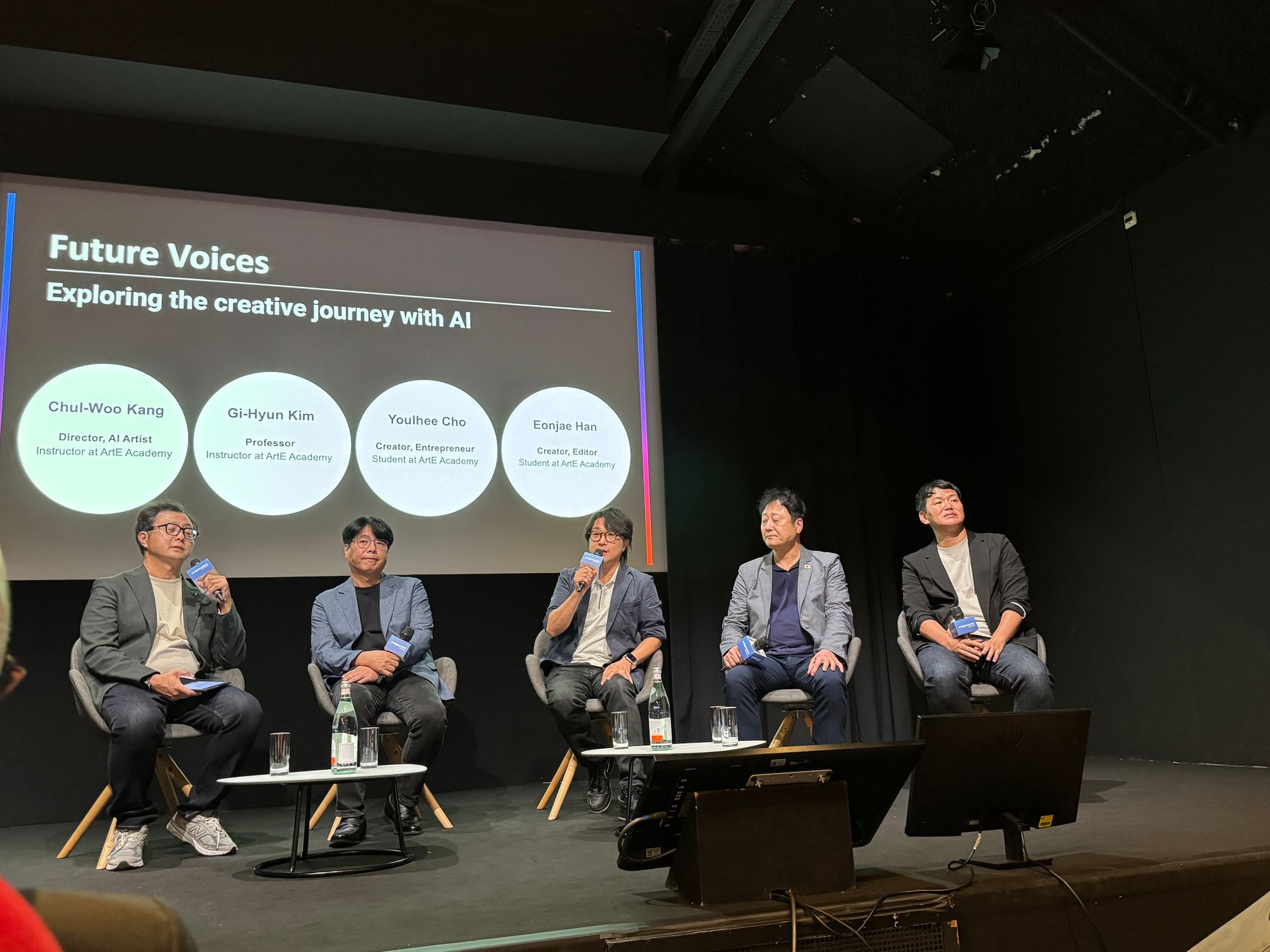
정송 교수 "한국, AI 기술과 문화의 교차점"
첫 번째 연사인 KAIST 김재철AI대학원장 정송 교수는 '한국 AI 예술·문화 콘텐츠 개발의 동향과 전망'을 주제로 발표했다. 정 교수는 한국이 AI 기술 선도국이면서 동시에 K-콘텐츠로 세계 문화 시장을 이끄는 독특한 위치에 있다고 설명하며, 이 두 영역의 강점을 결합할 수 있는 최적의 조건을 갖춘 국가가 바로 한국이라고 강조했다.
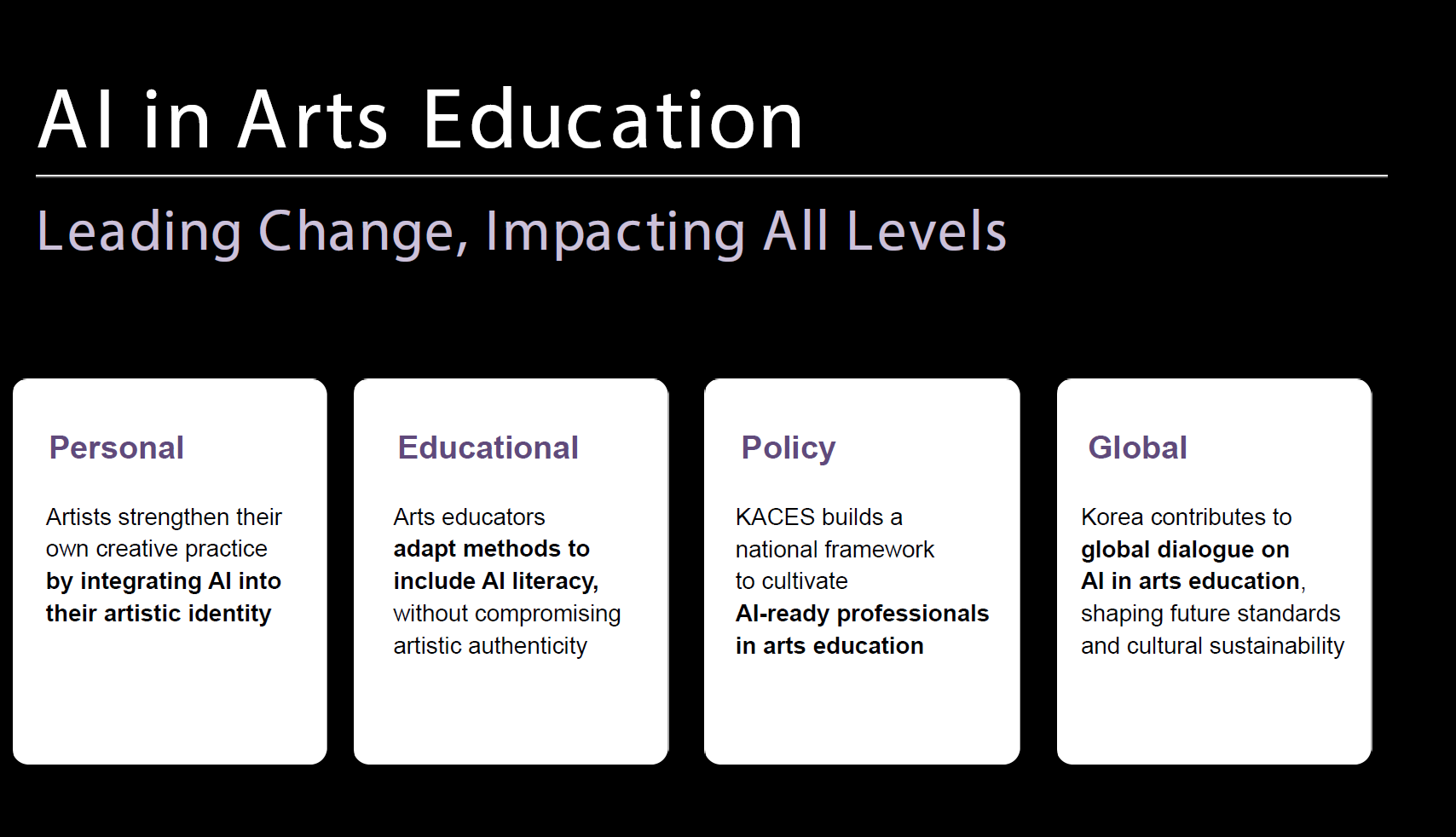
김자현 실장 "예술가가 주도, AI는 동반자"
이어진 김자현 한국문화예술교육진흥원 실장의 발표는 50일 교육과정의 철학과 방법론을 제시했다. 김 실장은 'AI와 예술 교육: 차세대 창의적 리더 양성'을 주제로 "디지털 네이티브 세대가 이미 AI로 자유롭게 창작하고 있는 시대에, 예술적 진정성을 지키는 것이 그 어느 때보다 중요해졌다"며 "예술교육은 창의성을 깊이 있게 인간적으로 유지해야 한다"고 강조했다.
그는 "누가 창작을 주도하는가? 기술인가, 인간 정신인가?"라는 근본적 질문을 던지며, "창의성은 인간의 예술성 없이는 진정한 본질을 잃는다. 예술가가 창작을 이끌고, AI는 혁신의 파트너가 되어야 한다. 미래 지향적 교육자들은 예술성과 AI를 결합하되, 창의성이 이끌고 기술이 따르도록 해야 한다"는 명확한 철학을 제시했다.
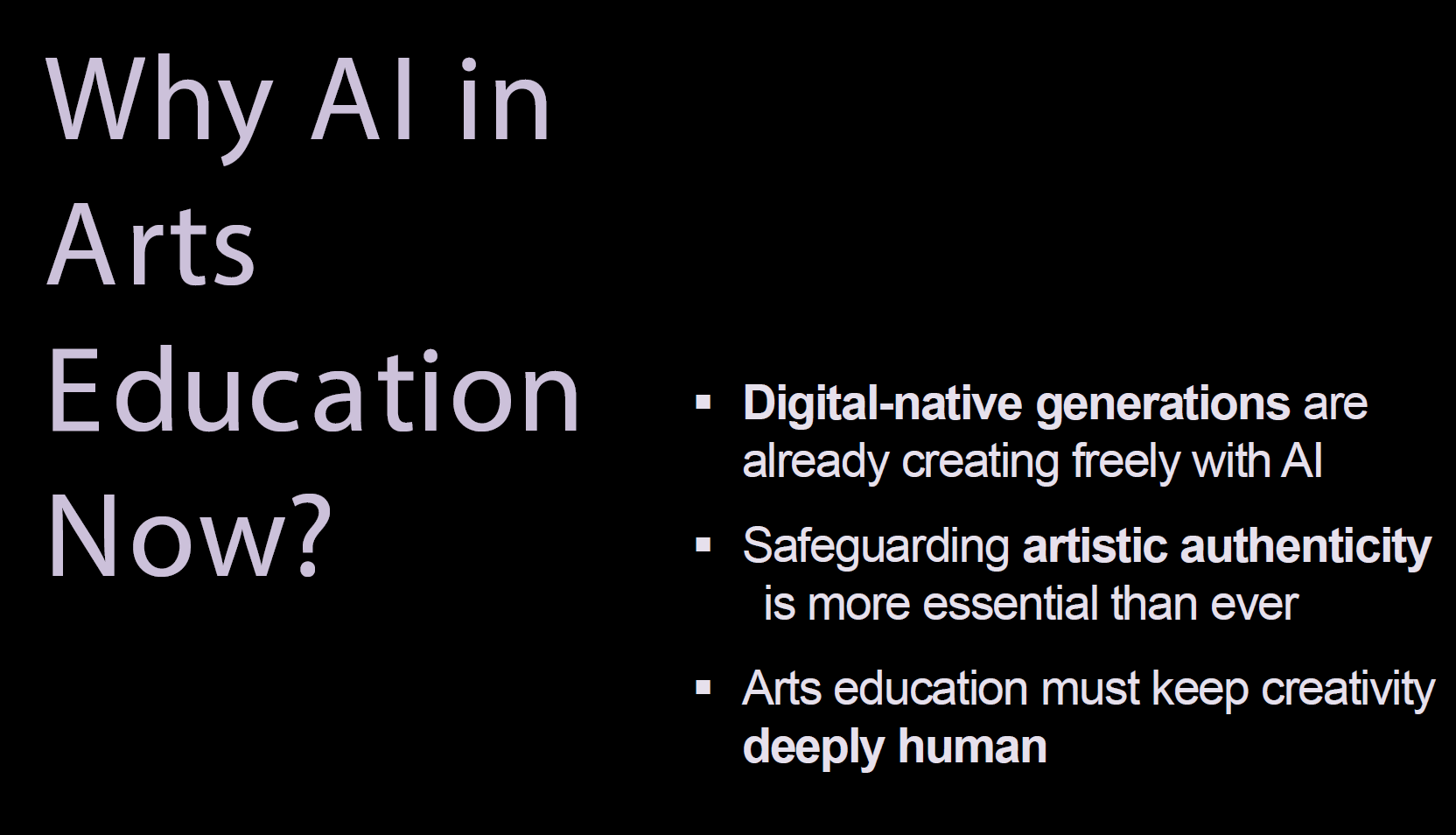
20년 인프라 위 50일 프로그램
김 실장은 KACES의 역사와 50일 교육과정의 구체적 내용을 소개했다. 2005년 문화체육관광부 산하 기관으로 설립된 KACES는 예술문화교육지원법에 근거해 학교와 지역사회의 예술교육 프로그램을 지원하고, 전문가 양성과 협력 네트워크를 구축하며, 국제 교류를 주도해왔다.
특히 산하 국립예술문화교육원인 아르떼 아카데미는 '변화하는 세계를 위한 창의적 역량 촉진'이라는 비전 아래 지금까지 35,000명의 인증 전문가와 150,000명의 교육 참가자를 배출했다. 이 20년간 구축된 인프라 위에서 창작자들의 AI 활용 능력과 범위를 확대하기 위한 50일간의 집중 교육과정을 운영했다.
김 실장은 50일 프로그램의 세 가지 핵심 원칙을 제시했다. ▲도구를 넘어서(Beyond Tools) 창의적 잠재력과 윤리적 사용을 고민하고 ▲창의적 목소리와 전문성(Creative Voice & Expertise)을 통해 예술적 정체성과 스토리텔링을 강화하며 ▲협력적 학습(Collaborative Learning)을 통해 예술가와 기술자가 함께 예술교육의 새로운 모델을 공동창조한다는 것이다.
네 가지 차원의 영향력
김 실장은 AI 예술교육의 영향력을 네 가지 차원으로 제시했다. 개인적 차원에서 예술가들은 AI를 자신의 예술적 정체성에 통합해 창작 실천을 강화한다. 교육적 차원에서 예술교육자들은 예술적 진정성을 훼손하지 않으면서 AI 리터러시를 교육 방법론에 포함시킨다. 정책적 차원에서 KACES는 AI 준비가 된 전문가들을 체계적으로 양성하기 위한 국가적 프레임워크를 구축한다. 글로벌 차원에서 한국은 예술교육에서의 AI 활용에 대한 국제적 대화를 주도하며 미래 표준을 만들어간다.
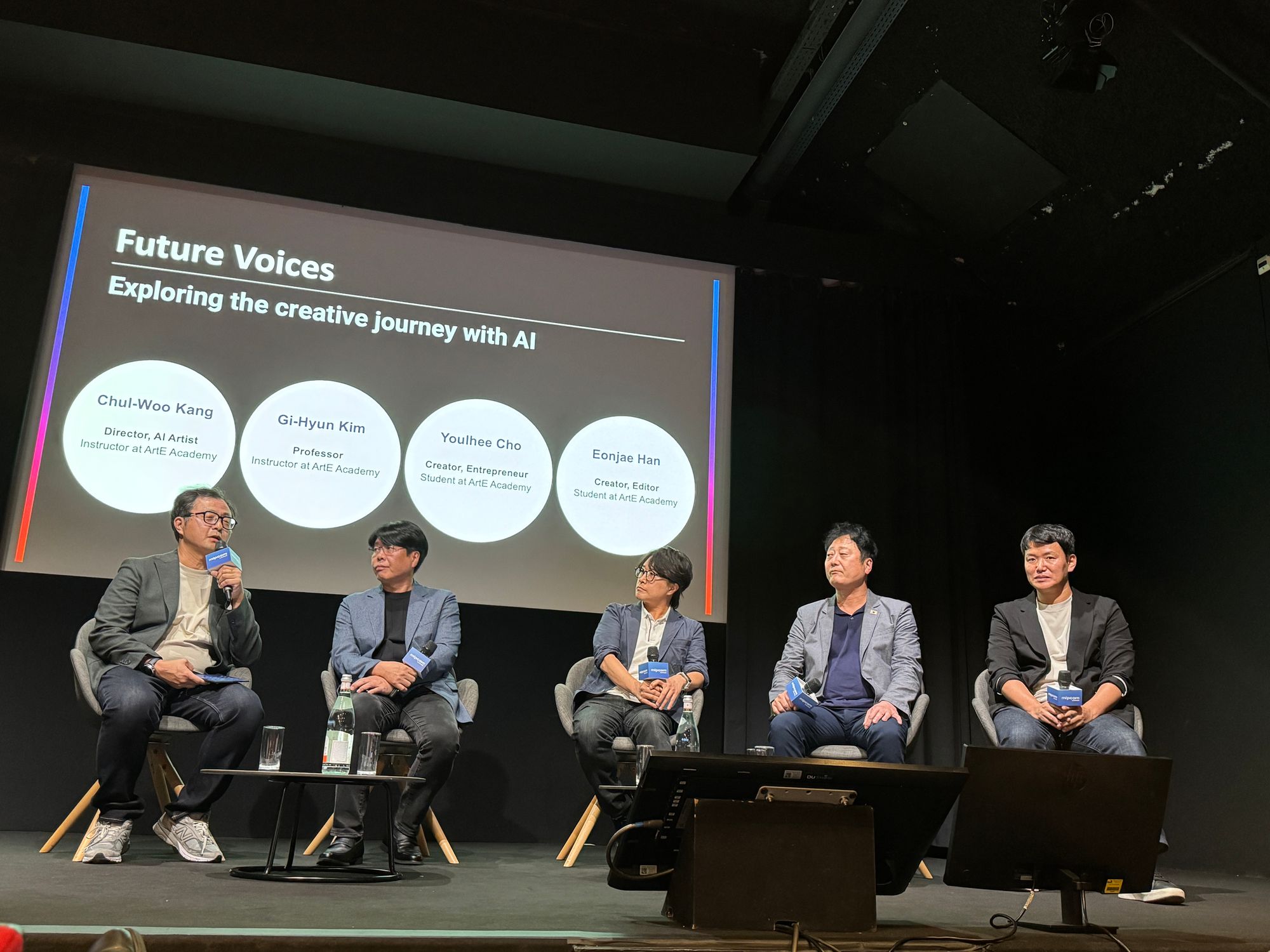
김호상 KT ENA 대표 "실제 산업 현장의 AI 활용"
KT ENA 김호상 대표는 'AI 기반 콘텐츠 제작'을 주제로 실제 산업 현장의 사례를 소개했다. 김 대표는 드라마 '마이 골든 스타'에서 AI를 활용해 역사적 장면을 재현함으로써 제작비와 시간을 대폭 절감한 사례, AI로 채널 홍보 영상을 제작해 효율성을 극대화한 경험, 한국 문화 요소를 강조하는 AI 더빙 기술과 AI 기반 프로젝트를 개발하여 글로벌 시장 진출 가능성을 확장한 사례 등을 구체적으로 공유했다.
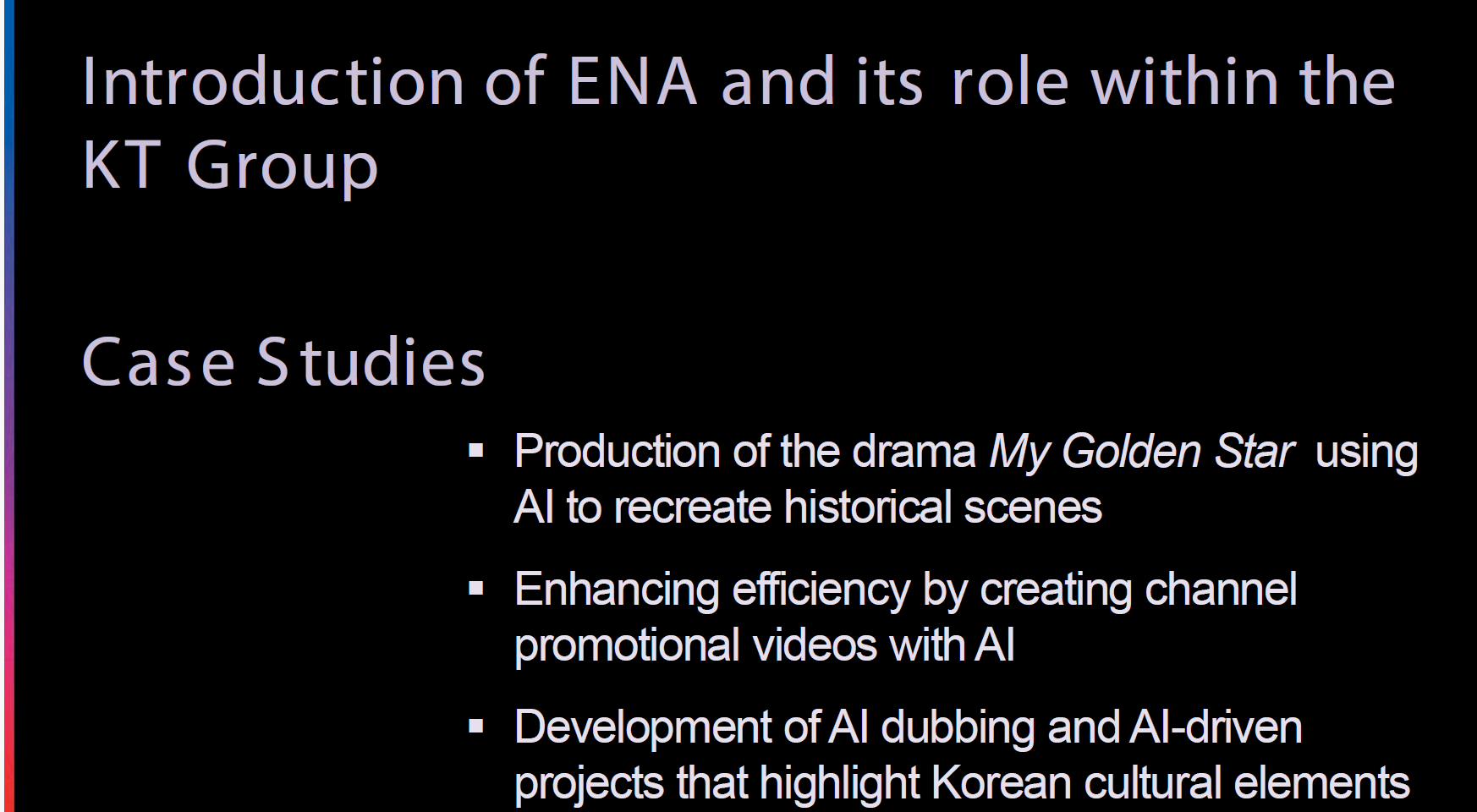
50일 프로그램의 실제: 학습에서 창작으로
라운드테이블 토론에서는 50일 교육과정의 구체적 내용과 성과가 공유됐다. 프로그램의 목적에 대한 질문에 강사는 "단순히 기술을 가르치는 것을 넘어, 예술가들이 AI를 통해 창작의 세계를 확장할 수 있도록 역량을 부여하는 것이었다"며 "많은 예술가들이 비전과 상상력을 가지고 있지만 비용·시간·자원이라는 장벽에 부딪힌다. AI는 이러한 장벽을 제거해 예술가들에게 한계 없이 창작할 수 있는 힘을 돌려주었다"고 설명했다.
총 50일간 진행된 프로그램은 단계적으로 구성됐다. 초반에는 기초와 도구 사용법을 배우고, 중반에는 아이디어를 실제 작품으로 발전시켰으며, 마지막 단계에서는 상업 영상 제작, 전시 기획, 브랜드 협업 등 실질적 응용으로 확장됐다. 강사는 "처음에는 '학습'으로 시작했지만 끝으로 갈수록 '실제 창작과 성과'로 이어졌다"고 평가했다.
참여자 배경은 매우 다양했다. 배우, 작가, 감독, 디자이너, 기업가뿐만 아니라 브랜딩과 디지털 디자인 전문가들도 참여했다. 사용된 도구는 콘셉트 시각화를 위한 이미지 생성, 영화적 스토리텔링을 위한 영상 생성 및 편집, 오리지널 스코어를 위한 음악 AI, 내레이션과 공연을 위한 음성 합성 등 네 가지 영역으로 나뉘었다.
전문가 수준의 AI 생성물
프로그램의 성과에 대해 강사는 "수십 편의 고퀄리티 영상, 이미지, 사운드 작품들이 완성됐다. 일부는 전시로 이어졌고, 일부는 실제 캠페인에 사용됐다"며 "주목할 점은 작품들이 '학생 수준'이 아니라 상업적 잠재력을 지닌 전문적 결과물이었다는 것이다. 이것이 짧은 기간에 이뤄낸 큰 성과였다"고 평가했다.
강사는 "한 작곡가는 Suno를 활용해 단 3일 만에 전문 영화 음악 수준의 사운드트랙을 완성했다"고 구체적인 사례를 들었다.
학생 조열희 대표는 "처음에는 50일이라는 기간이 긴 약속처럼 느껴졌지만, 단계적으로 구성되어 있어 오히려 집중하기 쉬웠다"며 "초반에 기초를 배우면서 자신감을 얻었고, 압도되지 않았다. 중반에 아이디어를 실제 프로젝트로 바꾸면서 성취감을 느꼈고, 마지막 단계에서는 '이건 단순한 연습이 아니라 내 커리어에 실제로 활용할 수 있는 것'이라는 깨달음을 얻었다"고 말했다.
특히 참가자들의 변화 과정이 주목받았다. 학생 한언제 편집자는 "처음에는 많은 사람들이 긴장했고, 일부는 AI가 우리의 예술을 대체하지 않을까 걱정했다"고 고백했다. 그러나 "직접 사용해보면서 오히려 우리의 창의적 목소리를 확장시켜준다는 것을 깨달았다. 상상만 했던 장면을 시각화했고, 다른 학생은 예산 문제로 포기했던 장면을 마침내 촬영할 수 있었다. 처음의 회의감은 흥분으로 바뀌었다"고 말했다.
"AI도입은 인간 대체가 아닌 상상력 확장"
한 참가자는 "수년간 꿈꿔왔던 프로젝트를 며칠 만에 완성했다"고 증언했고, 또 다른 참가자는 "AI를 배우면서 제 자신을 더 잘 이해하게 되었다"고 말해, AI 교육이 기술 습득을 넘어 자기 발견의 과정이 될 수 있음을 보여줬다.
강사로서 얻은 개인적 교훈에 대해 강철우 감독은 "AI가 놀라운 결과를 만들어낼 수 있지만, 인간의 철학과 감정이 담기지 않으면 예술이 될 수 없다"며 "이 과정을 통해 AI는 대체자가 아닌 동반자라는 확신이 더욱 굳어졌다. AI는 예술가의 본질을 확장시킬 수는 있어도 절대 진정으로 대체할 수는 없다"고 말했다.
교육 과정에서 가장 강조한 메시지는 "AI는 단지 도구일 뿐이고, 예술가의 목소리가 핵심"이라는 것이었다. 강사는 "기술은 정체성을 대체하지 않고 오히려 확대시켜준다. 실제로 한 참여자는 'AI를 배우면서 제 자신을 더 잘 이해하게 되었다'고 말했는데, 이것이 우리가 그들에게 발견하게 하고 싶었던 힘"이라고 설명했다.
예술가들이 AI를 사용할 때 주의해야 할 점에 대한 질문에 학생 한언제 편집자는 "가장 중요한 것은 균형"이라고 답했다. "AI가 놀라운 것들을 할 수 있어도, 자신의 목소리와 철학을 담지 않으면 그저 또 하나의 이미지나 소리에 불과하다. 계속해서 'AI는 수단이고, 당신의 메시지가 목표다'라는 말을 들었는데, 이것은 제가 앞으로 계속 간직할 것이다."
도전과 극복
가장 큰 어려움은 참여자들의 기술 수준 격차였다. 강사는 "1:1 피드백을 통해 프로젝트를 관리했고, 결국 출발선이 달랐음에도 모두가 과정을 성공적으로 완주할 수 있었다"고 설명했다.
학생 관점에서 한언제 편집자는 "저에게 가장 힘들었던 점은 초반의 가파른 학습 곡선이었다. AI 도구를 전혀 다뤄본 적이 없어서 처음에는 따라갈 수 있을까 걱정했다"고 털어놓았다. 그러나 "강사님들의 1:1 지원과 그룹 활동에서의 지식 공유가 큰 도움이 되었고, 시간이 지나면서 '기술을 완벽하게 다루는 것'보다 '내 아이디어를 표현하는 데 활용하는 것'이 더 중요하다는 걸 깨달았다. 그 순간 어려움이 오히려 동기부여로 바뀌었다"고 말했다.'
"한국 예술계의 전환점"
이 경험이 한국 예술계에 미칠 영향에 대해 강사는 "이번 프로그램은 한국 예술계의 전환점"이라며 "이제 예술가들은 예산이나 규모의 한계 없이 세계적 수준의 작품을 창작할 수 있고, 개인도 영화나 멀티미디어 작품을 글로벌 무대에 올릴 수 있다"고 전망했다.
또한 "AI는 모든 사람이 예술을 통해 자신을 표현하기 쉽게 만들어 더 많은 상상력과 참여를 가능하게 한다. 예술교육자들에게 AI는 예술을 모두에게 더 개방적이고 환영하는 것으로 만드는 유용한 도구들을 제공한다"고 덧붙였다.
"시작에 불과하다"
세션 마지막에 강사는 "이번 50일의 여정은 시작에 불과하다. 오늘 발표되는 작품들이야말로 예술가와 AI가 함께할 때 어떤 가능성이 열리는지를 증명한다"고 말했다.
학생 조열희 대표는 "맞습니다. 저희에게는 훨씬 더 큰 여정의 시작일 뿐입니다. 이제 AI와 함께라면 글로벌 무대에도 자신 있게 설 수 있다고 느낍니다"라고 화답했다.
강사는 "관심과 응원에 감사드리며, 앞으로도 여러분과 함께 이 여정을 이어가고 싶다"며 세션을 마무리했다.
정한 대표는 폐회사에서 "이 세션이 의미 있는 대화와 새로운 협력을 고취시켜, 우리가 함께 AI와 함께하는 미래 창의 리더를 양성해나가기를 바란다"며 "질문이나 토론을 계속하고 싶으신 분들은 부스를 방문해 달라"고 말했다.
[취재 후기] 결과물이 증명한 체계적 교육의 힘
MIPCOM 세션을 취재하며 가장 인상적이었던 것은 한국문화예술교육진흥원의 50일 교육과정이 만들어낸 구체적 성과였다. 이것은 이론과 철학만 제시하는 세미나가 아니라, 실제 AI 생성 작품들을 세계에 선보이고 교육 과정에서 얻은 교훈을 공유하는 성과발표회였다.
'35,000명의 인증 전문가'와 '150,000명의 교육 참가자'라는 20년 인프라 위에서 운영된 50일간의 집중 교육. 그 결과 '학생 수준'이 아닌 '전문가 수준'의 상업적 잠재력을 지닌 작품들이 탄생했다. 일부는 전시로, 일부는 실제 캠페인에 사용됐다. 숫자와 결과물이 증명하는 체계적 교육의 힘이었다.
김자현 실장이 제기한 "누가 창작을 주도하는가? 기술인가, 인간 정신인가?"라는 질문은 생성형 AI 시대 모든 창작자가 직면한 근본적 딜레마다. 50일 교육과정이 제시한 답은 명확했다. "예술가가 창작을 이끌고, AI는 혁신의 파트너가 된다."
강철우 감독의 "AI가 놀라운 결과를 만들어낼 수 있지만, 인간의 철학과 감정이 담기지 않으면 예술이 될 수 없다"는 말은, 기술 결정론에 대한 비판적 성찰이자 예술의 본질에 대한 재확인이었다. 이것이 단순한 선언이 아니라 50일간의 체계적 프로그램을 통해 실제 작품으로 구현됐다는 점에서 설득력을 갖는다.
특히 주목할 것은 프로그램의 단계적 구조다. 학습→창작→실제 응용으로 이어지는 체계적 설계, 1:1 피드백을 통한 기술 격차 극복, 배우·작가·감독·디자이너·기업가 등 다양한 배경의 참여자가 만들어낸 시너지. 이 모든 것이 유기적으로 결합되어 참가자들이 '회의'에서 '흥분'으로, '학습'에서 '창작'으로 변화했다.
한언제 편집자의 "이건 단순한 연습이 아니라 내 커리어에 실제로 활용할 수 있는 것"이라는 고백과, "AI를 배우면서 제 자신을 더 잘 이해하게 되었다"는 다른 참가자의 증언은, AI 교육이 기술 습득을 넘어 자기 발견과 역량 강화의 과정이 될 수 있음을 보여준다.
"AI는 수단이고, 당신의 메시지가 목적이다"라는 명제가 50일간 반복됐고, 그 결과 전문가 수준의 AI 생성물이 탄생했다. 이 철학과 결과물이 35,000명의 전문가와 150,000명의 참가자를 통해 확산되고 있다는 점에서, 한국의 AI 예술교육 모델은 글로벌 표준으로 발전할 가능성을 충분히 보여준다.
"시작에 불과하다"는 마지막 말처럼, 한국 예술교육계의 더 큰 여정이 시작됐다. 중요한 것은 이 여정이 최근의 AI 열풍에 편승한 것이 아니라, 20년간 쌓아온 단단한 인프라 위에서 출발하고, 50일간의 집중 교육을 통해 구체적 성과로 검증됐다는 점이다. 그것이 이번 MIPCOM 세션이 국제 예술교육계의 주목을 받은 이유다.
K엔터테크허브가 모더레이터로 함께한 이 세션은, 한국이 AI 예술교육의 철학뿐만 아니라 구체적 교육 방법론과 결과물까지 갖춘 완성도 높은 모델을 세계에 제시한 역사적 순간이었다.

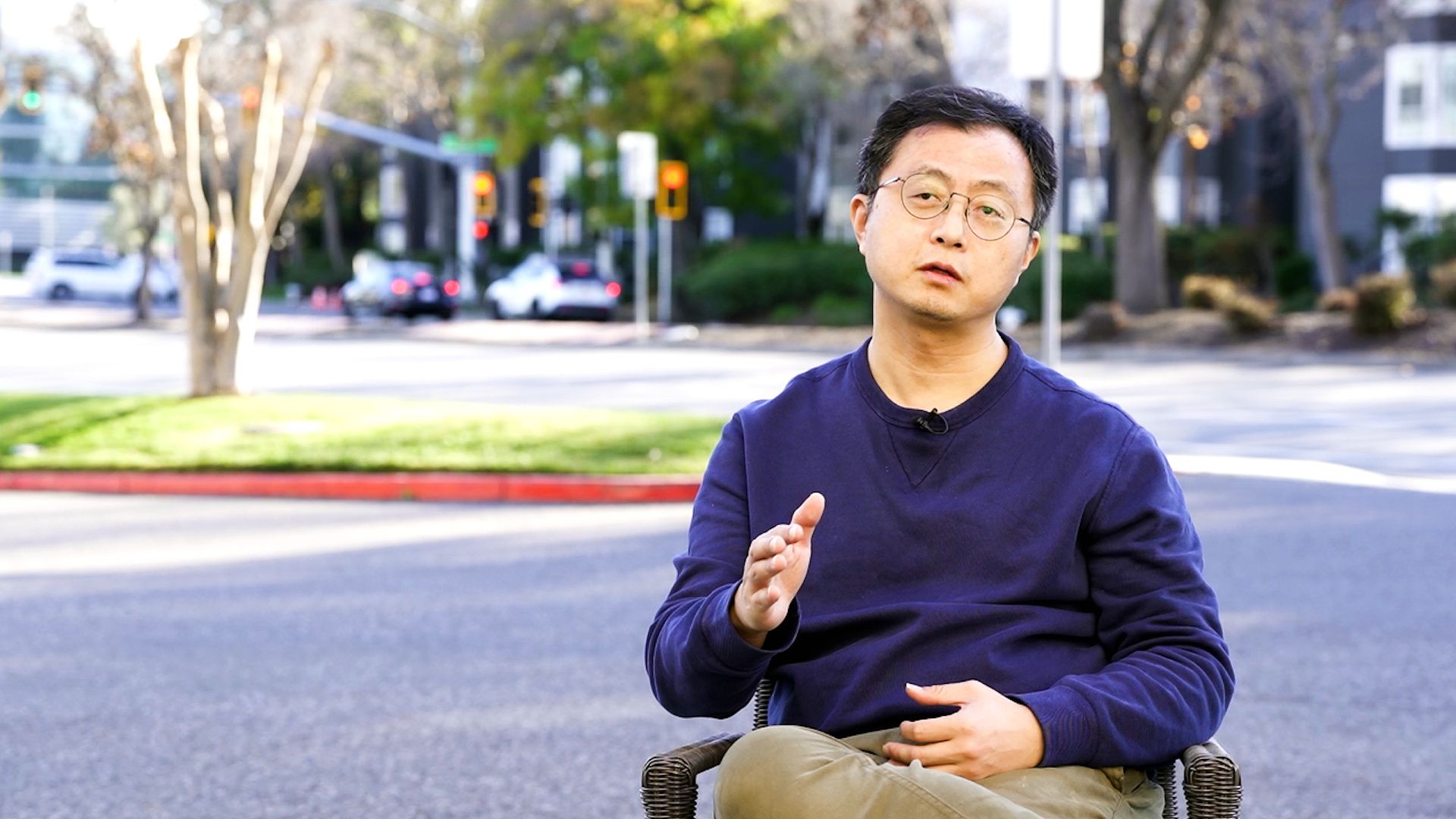
![[분석]넷플릭스-워너브라더스 115조 빅딜, ‘자기파괴적 혁신’이 부른 스트리밍 패권 2막](https://cdn.media.bluedot.so/bluedot.kentertechhub/2025/12/7ikm03_202512070029.png)
![[알림] 1월 7일 넥스트 K웨이브:엔터테크 포럼 @CES2026](https://cdn.media.bluedot.so/bluedot.kentertechhub/2025/11/91qe0z_202511281019.png)
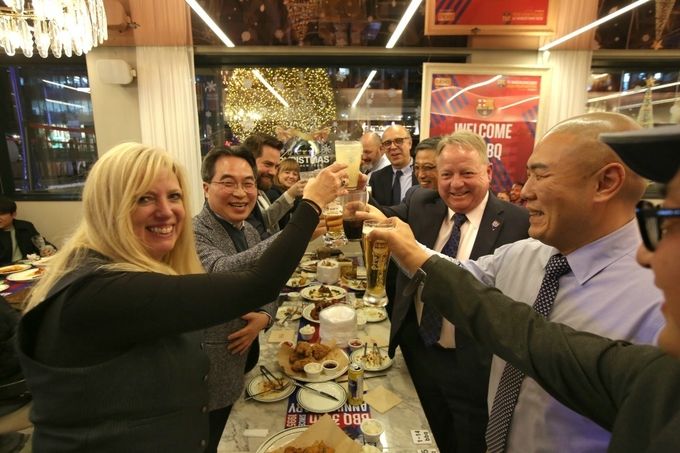
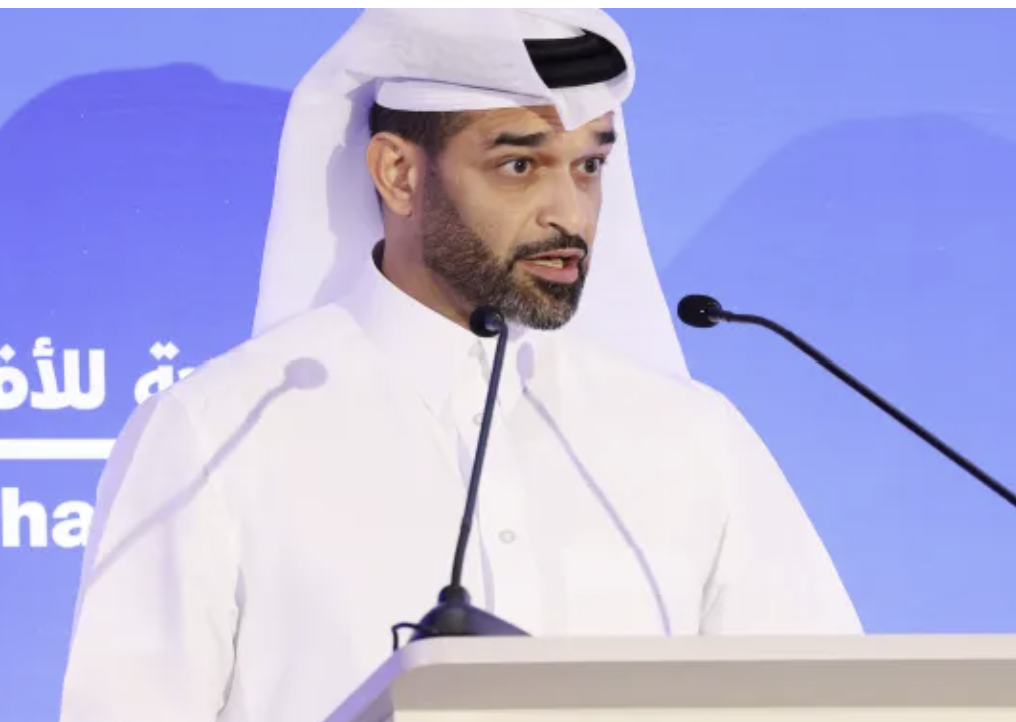
![[보고서]K-콘텐츠, 몰입형 공간 새로운 경험](https://cdn.media.bluedot.so/bluedot.kentertechhub/2025/12/je15hi_202512061434.png)
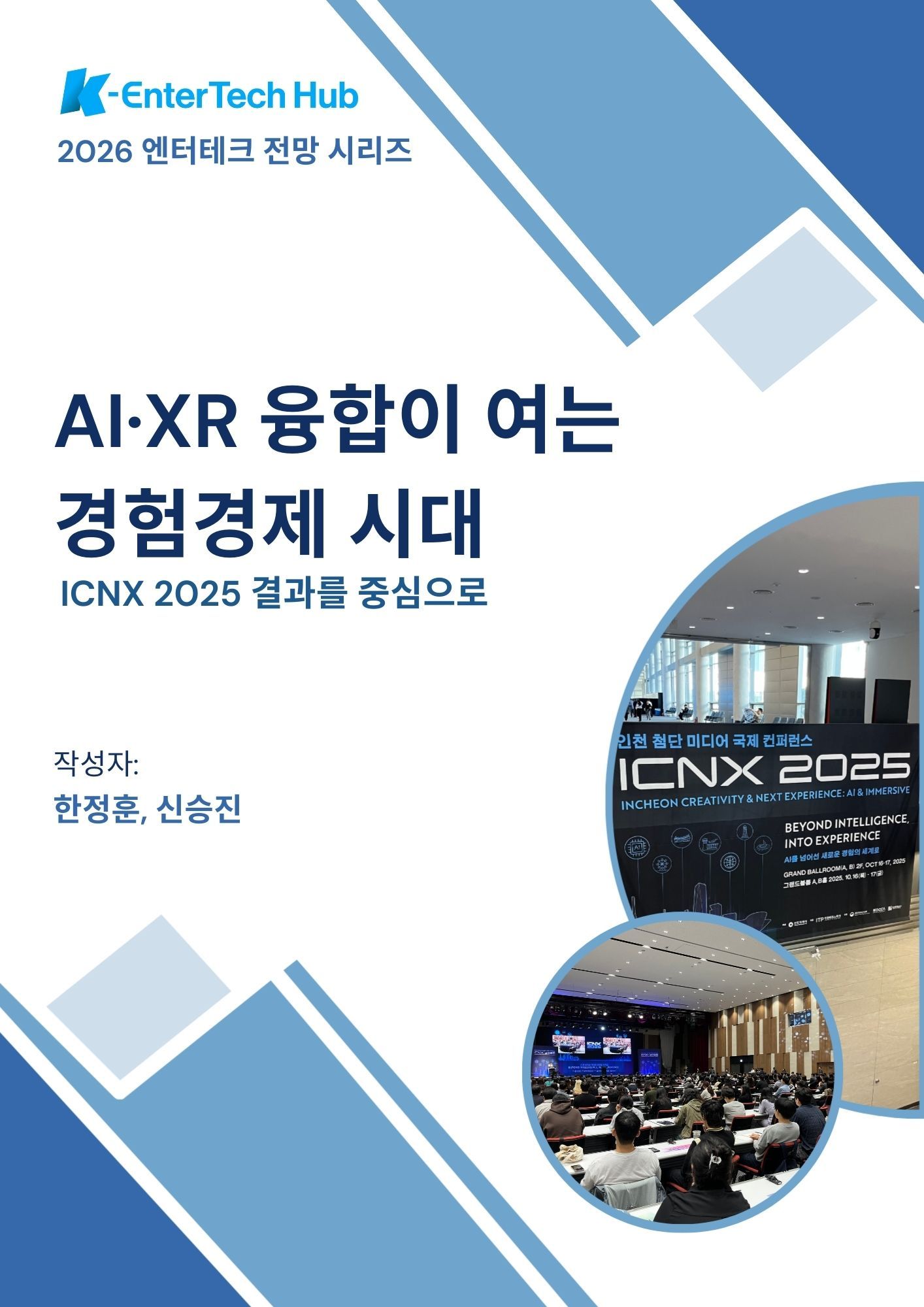
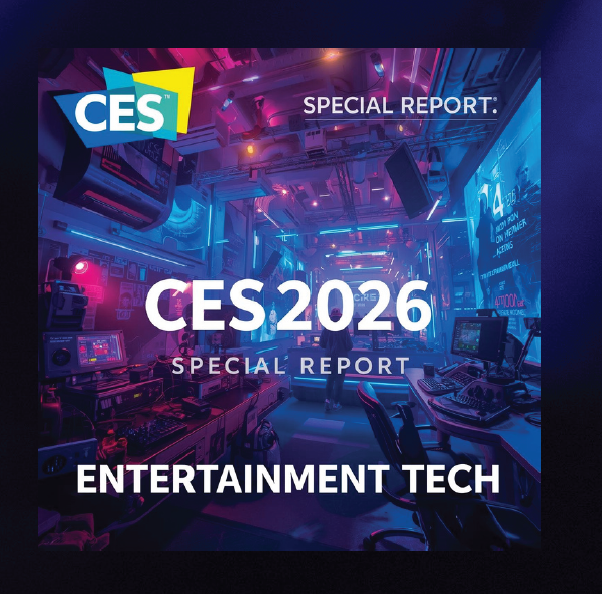
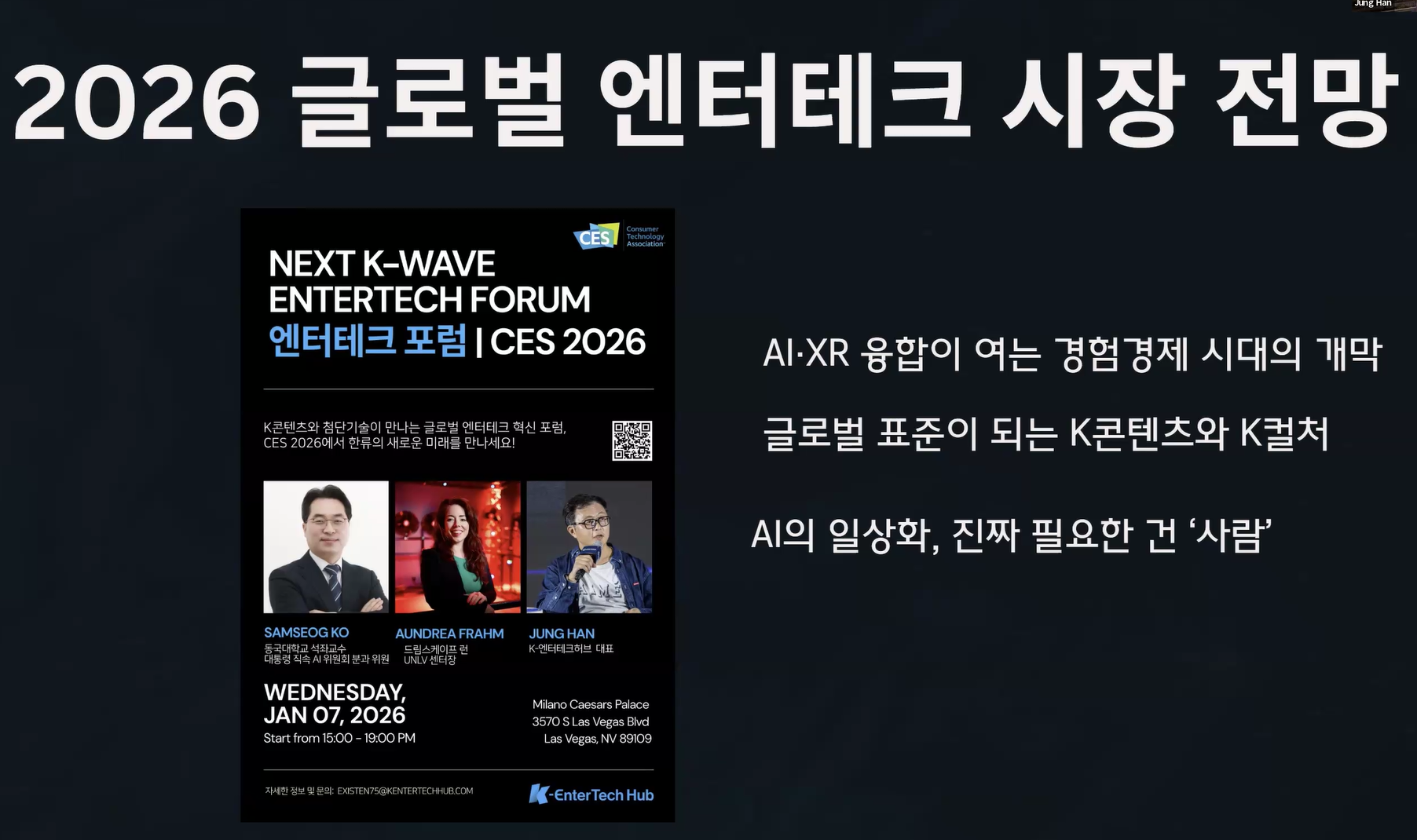
![[K콘텐츠와 K FAST]](https://cdn.media.bluedot.so/bluedot.kentertechhub/2025/11/zxwbgb_202511241038.jpg)
![[모집]1월 9일~14일 글로벌 AI 스템 캠프(자료집)](https://cdn.media.bluedot.so/bluedot.kentertechhub/2025/11/3kf0x5_202511031830.png)
![[MIPCOM2025]글로벌 엔터테인먼트 트렌드](https://cdn.media.bluedot.so/bluedot.kentertechhub/2025/10/duxlsp_202510170000.png)
![[보고서]생성AI와 애니메이션](https://cdn.media.bluedot.so/bluedot.kentertechhub/2025/09/c49fxu_202509271057.png)
